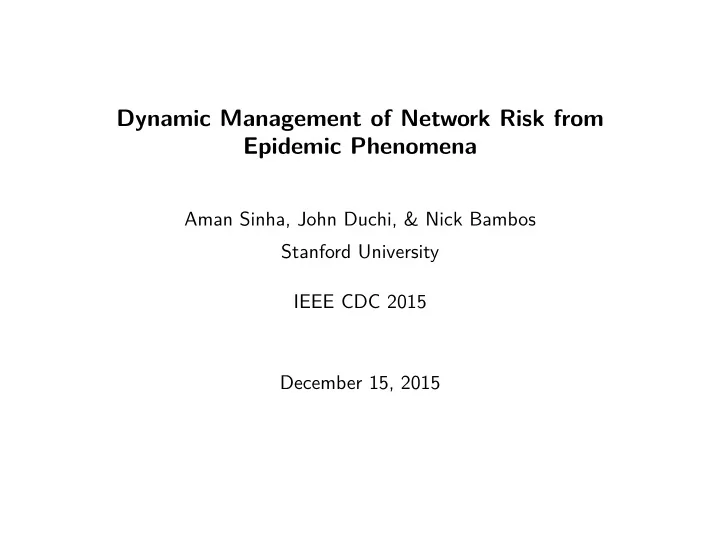

Dynamic Management of Network Risk from Epidemic Phenomena Aman Sinha, John Duchi, & Nick Bambos Stanford University IEEE CDC 2015 December 15, 2015
Analyzing Epidemics • Classic models (SIS, SIR) now generalized to probabilistic models of infection (Ganesh et al. 2005) • Widely applicable - digital/biological viruses, network router faults, social media influence, etc. • Control – Optimization approaches explicitly include budget constraints (Gourdin et al. 2011, Preciado et al. 2013, Preciado et al. 2014) – Our methods also deal with decentralization and robustness Sinha, Duchi, & Bambos. Dynamic Management of Network Risk 2
Outline Model Framework Proposed Approach Experiments Conclusions & Future Work Model Framework Sinha, Duchi, & Bambos. Dynamic Management of Network Risk 3
System Dynamics • SIS epidemic model as a continuous-time Markov process s = [ s 1 , s 2 , ..., s N ] T ∈ { 0 , 1 } N 1 b 1 A 21 env 1 → 0 at rate r i 0 → 1 at rate e T s i ( t ) : i A s ( t ) + e T i b s env ( t ) 2 3 s env ( t ) : 1 → 0 at rate r env • Instantaneous energy of infection √ P ( 1 T s ( t ) > 0) ≤ N � z ( t ) � 2 z ( t ) = D z ( t ) + b e − r env t s env (0) , ˙ z (0) = s (0) , D := A − diag( r ) Model Framework Sinha, Duchi, & Bambos. Dynamic Management of Network Risk 4
Problem Setup • Control environmental impact on system via limited budget at discrete intervals – Discretize dynamics: x ( k ) := z ( kh ) – Control b w.r.t budget constraints u ( k ) = ( b − w ( k )) e − r env kh s env (0) 0 � w ( k ) � b , � w ( k ) � 1 ≤ c, • Minimize cumulative energy of infection via MPC T � ∞ � ∞ √ √ � P ( 1 T s ( t ) > 0) dt ≤ N � z ( t ) � 2 dt ≈ N � x ( k ) � 2 0 0 k =0 T + m √ � minimize J m := � x ( k ) � 2 N k = m +1 subject to ( dynamics, constraints ) Model Framework Sinha, Duchi, & Bambos. Dynamic Management of Network Risk 5
Problem Setup (contd.) • Centralized solution is inefficient for large N and network connectivity might not be known perfectly • Decentralization - split system into M (possibly unequal) subsystems • Robustness - off-diagonal blocks of A are known only within some uncertainty region Model Framework Sinha, Duchi, & Bambos. Dynamic Management of Network Risk 6
Outline Model Framework Proposed Approach Experiments Conclusions & Future Work Proposed Approach Sinha, Duchi, & Bambos. Dynamic Management of Network Risk 7
Reduced-Order Models • Each subsystem models the other subsystems’ dynamics through reduced-order models (decentralization/accuracy tradeoff) • Standard model reduction procedure (e.g. via balanced truncation, Safonov et al. 1988) – Procedure outputs compression and expansion operators – Analogous to similarity transformation • Local problem for subsystem i (with state x i r , control u i r ): √ T + m � minimize J i � x i m := N r ( k ) � 2 k = m +1 subject to ( reduced dynamics, reduced constraints ) Proposed Approach Sinha, Duchi, & Bambos. Dynamic Management of Network Risk 8
Robust Formulation • Polytopic/"scenario" uncertainty sets (efficiency/robustness tradeoff) L mn L mn � � A mn = { C | C = µ k A mn ( k ) , µ k ≥ 0 , µ k = 1 } k =1 k =1 A mn • Straightforward generalization for model reduction via generalized balanced truncation (replace Lyapunov eq. with LMI) • Robust counterpart for local problem ( min sup A J i m ) is an SOCP – Requires linearizing dynamics s.t. x i r ( k ) is affine in A Proposed Approach Sinha, Duchi, & Bambos. Dynamic Management of Network Risk 9
Outline Model Framework Proposed Approach Experiments Conclusions & Future Work Experiments Sinha, Duchi, & Bambos. Dynamic Management of Network Risk 10
Experiments • N = 24 , M = 3 , equal subsystem sizes, random adjacency matrices and recovery rates • Environment heals, but at a slower rate than the system – s env (0) = 1 , r env = 0 . 2 < − λ i ( D ) ∈ [0 . 33 , 1] • We vary the order of reduced models, k i = { 0 , 2 , 4 , 6 , 8 } • Compare with no control, anarchy (each subsystem has budget c/M ) Experiments Sinha, Duchi, & Bambos. Dynamic Management of Network Risk 11
Experiments (contd.) • Cooperation/dynamic budget allocation assuages overshoot • Larger k i yields better performance No Control 9 Anarchic k i = 0 k i = 2 8 k i = 4 k i = 6 7 Centralized � x ( m ) � 2 6 5 4 3 2 0 40 80 120 160 m Experiments Sinha, Duchi, & Bambos. Dynamic Management of Network Risk 12
Outline Model Framework Proposed Approach Experiments Conclusions & Future Work Conclusions & Future Work Sinha, Duchi, & Bambos. Dynamic Management of Network Risk 13
Conclusions & Future Work • Developed framework for dynamic network protection incorporating budget constraints, decentralization, and robustness to uncertainty • Tradeoffs between efficiency/robustness and decentralization/optimality • Many avenues worth further research – Uncertainty sets with greater scalability – Optimal decentralized schemes for partitioning budgets between subsystems – Dynamic network topologies Conclusions & Future Work Sinha, Duchi, & Bambos. Dynamic Management of Network Risk 14
Recommend
More recommend